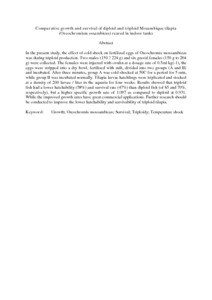Citation
Nwachi, O. F. and Esa, Yuzine B.
(2016)
Comparative growth and survival of diploid and triploid mozambique tilapia (Oreochromis mossambicus) reared in indoor tanks.
Journal of Environmental Biology, 37 (Special Issue).
pp. 839-843.
ISSN 0254-8704
Abstract
In the present study, the effect of cold shock on fertilized eggs of Oreochromis mossambicus was during triploid production. Two males (150 ? 224 g) and six gravid females (150 g to 264 g) were collected. The females were injected with ovulin at a dosage rate of 0.5ml kg(-1), the eggs were stripped into a dry bowl, fertilised with milt, divided into two groups (A and B) and incubated. After three minutes, group A was cold shocked at 50C for a period for 5 min, while group B was incubated normally. Tilapia larvae hatchlings were triplicated and stocked at a density of 200 larvae / liter in the aquaria for four weeks. Results showed that triploid fish had a lower hatchability (58%) and survival rate (47%) than diploid fish (of 85 and 70%, respectively), but a higher specific growth rate of 1.097 as compared to diploid at 0.931. While the improved growth rates have great commercial applications. Further research should be conducted to improve the lower hatchability and survivability of triploid tilapia.
Download File
![[img]](http://psasir.upm.edu.my/55325/1.hassmallThumbnailVersion/Comparative%20growth%20and%20survival%20of%20diploid%20and%20triploid%20Mozambique%20tilapia%20.pdf)  Preview |
|
PDF (Abstract)
Comparative growth and survival of diploid and triploid Mozambique tilapia .pdf
Download (4kB)
| Preview
|
|
Additional Metadata
Actions (login required)
 |
View Item |

